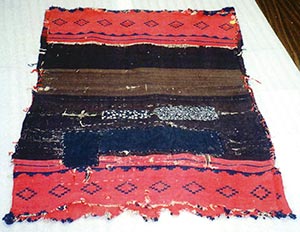Textile history
After more than a century, Juanita's dress is coming home
By Cindy Yurth
Tséyi' Bureau
CHINLE, Aug. 20, 2010

(Courtesy photo)
The dress woven and worn by Chief Manuelito's wife Juanita will be displayed at the Navajo Nation Museum. The dress is part of an exhibit on Chief Manuelito that will open with a public reception on Aug. 27.
Well, the dress is returning the visit.
On Tuesday, Aug. 24, a climate-controlled truck bearing the dress and a saddle blanket also woven by Juanita (whose Navajo name was Asdzáá Tl'ógí, "Weaver Woman") will roll into Window Rock where it will be met by Denetdale and Navajo Nation Museum Curator Clarenda Begay.
"I'm so, so excited," Begay said. "This is a big deal."
Unfortunately, the women won't be able to unpack the textiles until Thursday morning, 22 hours later. Good curation demands the 142-year-old dress and the somewhat newer blanket rest in their specially designed boxes for that long before being opened.
A curator from the Autry National Center (formerly the Southwest Museum) will accompany the items to make sure they're unpacked and exhibited correctly.
The items will be on loan as part of the museum's planned exhibit on Chief Manuelito, which will open with a public reception at 5 p.m. Friday, Aug. 27.
To the untrained eye, it may be hard to see what all the fuss is about. The dress is a tattered piece of woolen fabric, patched with calico in several places. But it's one of the few surviving artifacts of Juanita, a stateswoman in her own right who accompanied her husband on delegations to Washington.
"To see something that belonged to her, that she actually wove and wore, is really significant to me and all her descendants," said Denetdale, who is helping Begay with the exhibit. "But this isn't just family history. This is Navajo history. I hope everyone will want to see it."
Begay said the dress is a typical biil, or blanket dress, of its time. The design represents clouds, mountains and sky - the balance of Mother Earth and Father Sky so important in the Diné worldview.
Although it's evident from some of her other work that Juanita could have woven a more elaborate pattern, women's garments of the time were kept deliberately simple.
"It was a form of modesty," Begay explained. "You didn't want to stand out."
Looking at all the patches, "it's obvious she loved the dress and wore it a lot," Begay said.
Perhaps that was because the year she wove it - 1868 - was the year her husband and other Navajo leaders signed the treaty that freed their people from internment at Fort Sumner, N.M., and let them return home to their beloved land.
According to his own account when he donated the dress to the museum, photographer and collector George Wharton James obtained the dress from Juanita in 1874. Earlier, she had refused to sell it to him but later gave it to him as a gift.
She is wearing the biil in several photographs James took of her and her family over the years.
"Seeing the dress in pictures, and then really seeing it, makes you think about what she would have experienced and the things our people went through," Begay said.

